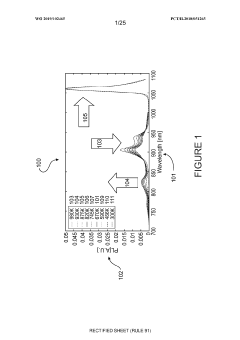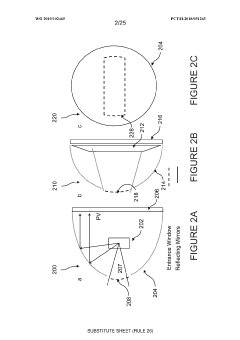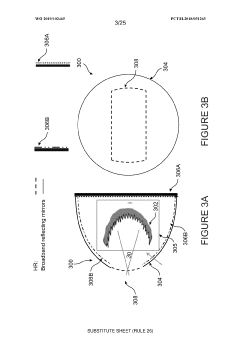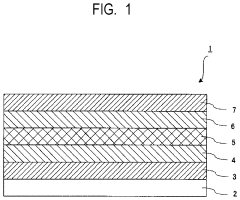Phenolphthalein in Solar Energy Harvesting Materials
JUL 24, 202510 MIN READ
Generate Your Research Report Instantly with AI Agent
Patsnap Eureka helps you evaluate technical feasibility & market potential.
Phenolphthalein in Solar Energy: Background and Objectives
Phenolphthalein, a compound traditionally known for its use as a pH indicator, has recently emerged as a promising material in the field of solar energy harvesting. This research direction represents a significant shift in the application of phenolphthalein, moving from its conventional role in analytical chemistry to a potential game-changer in renewable energy technologies.
The evolution of solar energy harvesting materials has been driven by the urgent need for sustainable and efficient energy sources. As global energy demands continue to rise and the environmental impacts of fossil fuels become increasingly apparent, the search for innovative solar materials has intensified. Phenolphthalein's unique properties, particularly its photochromic behavior and ability to undergo reversible structural changes upon exposure to light, have attracted considerable attention from researchers in the field of solar energy.
The primary objective of this research is to explore and evaluate the potential of phenolphthalein as a key component in next-generation solar energy harvesting materials. This involves a comprehensive investigation of its photophysical and photochemical properties, as well as its integration into various solar energy conversion systems. The goal is to harness phenolphthalein's light-responsive characteristics to enhance the efficiency and functionality of solar cells, photocatalysts, and other solar energy devices.
One of the key areas of focus is the development of phenolphthalein-based dye-sensitized solar cells (DSSCs). These cells offer a promising alternative to traditional silicon-based photovoltaics, potentially providing a more cost-effective and flexible solution for solar energy conversion. The research aims to optimize the molecular structure of phenolphthalein derivatives to improve their light absorption properties and electron transfer capabilities within DSSCs.
Another significant aspect of this research is the exploration of phenolphthalein's role in solar thermal energy storage systems. The compound's ability to undergo reversible color changes and structural transformations in response to temperature variations presents intriguing possibilities for developing advanced thermal energy storage materials. This could lead to more efficient and compact solar thermal systems for both industrial and residential applications.
Furthermore, the research seeks to investigate the potential of phenolphthalein in photocatalytic applications, particularly in the field of solar-driven water splitting for hydrogen production. The compound's light-sensitive properties could be leveraged to enhance the efficiency of photocatalysts, potentially contributing to the development of sustainable hydrogen production technologies.
As we delve into this research, we aim to not only advance our understanding of phenolphthalein's capabilities in solar energy harvesting but also to pave the way for practical applications that could significantly impact the renewable energy landscape. The ultimate goal is to contribute to the development of more efficient, cost-effective, and environmentally friendly solar energy technologies, addressing the global challenges of energy sustainability and climate change mitigation.
The evolution of solar energy harvesting materials has been driven by the urgent need for sustainable and efficient energy sources. As global energy demands continue to rise and the environmental impacts of fossil fuels become increasingly apparent, the search for innovative solar materials has intensified. Phenolphthalein's unique properties, particularly its photochromic behavior and ability to undergo reversible structural changes upon exposure to light, have attracted considerable attention from researchers in the field of solar energy.
The primary objective of this research is to explore and evaluate the potential of phenolphthalein as a key component in next-generation solar energy harvesting materials. This involves a comprehensive investigation of its photophysical and photochemical properties, as well as its integration into various solar energy conversion systems. The goal is to harness phenolphthalein's light-responsive characteristics to enhance the efficiency and functionality of solar cells, photocatalysts, and other solar energy devices.
One of the key areas of focus is the development of phenolphthalein-based dye-sensitized solar cells (DSSCs). These cells offer a promising alternative to traditional silicon-based photovoltaics, potentially providing a more cost-effective and flexible solution for solar energy conversion. The research aims to optimize the molecular structure of phenolphthalein derivatives to improve their light absorption properties and electron transfer capabilities within DSSCs.
Another significant aspect of this research is the exploration of phenolphthalein's role in solar thermal energy storage systems. The compound's ability to undergo reversible color changes and structural transformations in response to temperature variations presents intriguing possibilities for developing advanced thermal energy storage materials. This could lead to more efficient and compact solar thermal systems for both industrial and residential applications.
Furthermore, the research seeks to investigate the potential of phenolphthalein in photocatalytic applications, particularly in the field of solar-driven water splitting for hydrogen production. The compound's light-sensitive properties could be leveraged to enhance the efficiency of photocatalysts, potentially contributing to the development of sustainable hydrogen production technologies.
As we delve into this research, we aim to not only advance our understanding of phenolphthalein's capabilities in solar energy harvesting but also to pave the way for practical applications that could significantly impact the renewable energy landscape. The ultimate goal is to contribute to the development of more efficient, cost-effective, and environmentally friendly solar energy technologies, addressing the global challenges of energy sustainability and climate change mitigation.
Market Analysis for Solar Energy Harvesting Materials
The solar energy harvesting materials market has been experiencing significant growth in recent years, driven by the increasing global demand for renewable energy sources and the push towards sustainable development. This market segment is a crucial component of the broader solar energy industry, which has been expanding at a rapid pace due to technological advancements, cost reductions, and supportive government policies worldwide.
The global market for solar energy harvesting materials is projected to continue its upward trajectory, with a compound annual growth rate (CAGR) expected to remain in the double digits over the next five years. This growth is primarily attributed to the rising adoption of solar photovoltaic (PV) systems across residential, commercial, and utility-scale applications. Additionally, the increasing focus on building-integrated photovoltaics (BIPV) and the emergence of new applications such as solar-powered vehicles and wearable devices are creating new opportunities for market expansion.
Key market drivers include the declining costs of solar PV systems, improvements in solar cell efficiency, and the growing awareness of environmental issues related to fossil fuel consumption. Government initiatives, such as feed-in tariffs, tax incentives, and renewable portfolio standards, have also played a significant role in stimulating market growth across various regions.
The market for solar energy harvesting materials can be segmented based on material type, including silicon-based materials, thin-film materials, and emerging technologies such as perovskite and organic photovoltaics. Silicon-based materials, particularly crystalline silicon, continue to dominate the market due to their high efficiency and established manufacturing processes. However, thin-film technologies and emerging materials are gaining traction due to their potential for lower costs and improved performance in specific applications.
Geographically, Asia-Pacific leads the market, with China being the largest producer and consumer of solar energy harvesting materials. Europe and North America follow, with significant growth potential in emerging markets such as Latin America, the Middle East, and Africa. The increasing electrification efforts in developing countries and the growing adoption of off-grid solar solutions are expected to drive demand in these regions.
The competitive landscape of the solar energy harvesting materials market is characterized by the presence of both established players and innovative startups. Key market players are focusing on research and development activities to improve material efficiency, reduce production costs, and develop new technologies. Collaborations between material manufacturers, solar cell producers, and research institutions are becoming increasingly common as companies seek to gain a competitive edge in this rapidly evolving market.
The global market for solar energy harvesting materials is projected to continue its upward trajectory, with a compound annual growth rate (CAGR) expected to remain in the double digits over the next five years. This growth is primarily attributed to the rising adoption of solar photovoltaic (PV) systems across residential, commercial, and utility-scale applications. Additionally, the increasing focus on building-integrated photovoltaics (BIPV) and the emergence of new applications such as solar-powered vehicles and wearable devices are creating new opportunities for market expansion.
Key market drivers include the declining costs of solar PV systems, improvements in solar cell efficiency, and the growing awareness of environmental issues related to fossil fuel consumption. Government initiatives, such as feed-in tariffs, tax incentives, and renewable portfolio standards, have also played a significant role in stimulating market growth across various regions.
The market for solar energy harvesting materials can be segmented based on material type, including silicon-based materials, thin-film materials, and emerging technologies such as perovskite and organic photovoltaics. Silicon-based materials, particularly crystalline silicon, continue to dominate the market due to their high efficiency and established manufacturing processes. However, thin-film technologies and emerging materials are gaining traction due to their potential for lower costs and improved performance in specific applications.
Geographically, Asia-Pacific leads the market, with China being the largest producer and consumer of solar energy harvesting materials. Europe and North America follow, with significant growth potential in emerging markets such as Latin America, the Middle East, and Africa. The increasing electrification efforts in developing countries and the growing adoption of off-grid solar solutions are expected to drive demand in these regions.
The competitive landscape of the solar energy harvesting materials market is characterized by the presence of both established players and innovative startups. Key market players are focusing on research and development activities to improve material efficiency, reduce production costs, and develop new technologies. Collaborations between material manufacturers, solar cell producers, and research institutions are becoming increasingly common as companies seek to gain a competitive edge in this rapidly evolving market.
Current Challenges in Phenolphthalein-based Solar Materials
The integration of phenolphthalein into solar energy harvesting materials presents several significant challenges that researchers and developers must address. One of the primary obstacles is the stability of phenolphthalein under prolonged exposure to sunlight and varying environmental conditions. The photosensitive nature of phenolphthalein, while beneficial for its color-changing properties, can lead to degradation over time, potentially reducing the efficiency and lifespan of solar materials incorporating this compound.
Another critical challenge lies in optimizing the absorption spectrum of phenolphthalein-based solar materials. While phenolphthalein exhibits a strong color change in response to pH shifts, its natural absorption range may not align perfectly with the solar spectrum. This mismatch can limit the overall energy conversion efficiency of solar devices utilizing phenolphthalein, necessitating the development of strategies to broaden or shift its absorption profile to better capture the full spectrum of solar radiation.
The integration of phenolphthalein into existing solar cell architectures poses additional technical hurdles. Researchers must develop methods to incorporate phenolphthalein into solar materials without compromising the structural integrity or electrical properties of the device. This includes addressing potential issues related to electron transport and charge separation within the solar cell, as the introduction of phenolphthalein may alter the material's electronic characteristics.
Scalability and cost-effectiveness represent further challenges in the development of phenolphthalein-based solar materials. While phenolphthalein itself is relatively inexpensive, the processes required to effectively incorporate it into solar devices at a commercial scale may be complex and costly. Researchers must work towards developing manufacturing techniques that are both economically viable and capable of producing high-quality, consistent results.
Environmental concerns and regulatory compliance also present challenges in the widespread adoption of phenolphthalein-based solar materials. As with any new material introduced into consumer products, thorough safety assessments and lifecycle analyses are necessary to ensure that these solar materials do not pose risks to human health or the environment. This includes evaluating the potential for leaching or degradation products and their impact on ecosystems.
Lastly, the challenge of achieving long-term reliability and performance consistency in phenolphthalein-based solar materials cannot be overstated. Solar energy systems are expected to operate efficiently for decades, and any new material incorporated into these systems must demonstrate comparable durability. Researchers must develop accelerated aging tests and predictive models to assess the long-term behavior of phenolphthalein in solar applications, addressing potential issues such as color fading, chemical changes, or physical degradation that could impact the material's performance over time.
Another critical challenge lies in optimizing the absorption spectrum of phenolphthalein-based solar materials. While phenolphthalein exhibits a strong color change in response to pH shifts, its natural absorption range may not align perfectly with the solar spectrum. This mismatch can limit the overall energy conversion efficiency of solar devices utilizing phenolphthalein, necessitating the development of strategies to broaden or shift its absorption profile to better capture the full spectrum of solar radiation.
The integration of phenolphthalein into existing solar cell architectures poses additional technical hurdles. Researchers must develop methods to incorporate phenolphthalein into solar materials without compromising the structural integrity or electrical properties of the device. This includes addressing potential issues related to electron transport and charge separation within the solar cell, as the introduction of phenolphthalein may alter the material's electronic characteristics.
Scalability and cost-effectiveness represent further challenges in the development of phenolphthalein-based solar materials. While phenolphthalein itself is relatively inexpensive, the processes required to effectively incorporate it into solar devices at a commercial scale may be complex and costly. Researchers must work towards developing manufacturing techniques that are both economically viable and capable of producing high-quality, consistent results.
Environmental concerns and regulatory compliance also present challenges in the widespread adoption of phenolphthalein-based solar materials. As with any new material introduced into consumer products, thorough safety assessments and lifecycle analyses are necessary to ensure that these solar materials do not pose risks to human health or the environment. This includes evaluating the potential for leaching or degradation products and their impact on ecosystems.
Lastly, the challenge of achieving long-term reliability and performance consistency in phenolphthalein-based solar materials cannot be overstated. Solar energy systems are expected to operate efficiently for decades, and any new material incorporated into these systems must demonstrate comparable durability. Researchers must develop accelerated aging tests and predictive models to assess the long-term behavior of phenolphthalein in solar applications, addressing potential issues such as color fading, chemical changes, or physical degradation that could impact the material's performance over time.
Existing Phenolphthalein-based Solar Energy Solutions
01 Synthesis and production methods of phenolphthalein
Various methods for synthesizing and producing phenolphthalein are described, including different reaction conditions, catalysts, and purification techniques. These methods aim to improve yield, purity, and efficiency in the manufacturing process of phenolphthalein.- Synthesis and production of phenolphthalein: Various methods and processes for synthesizing and producing phenolphthalein are described. These include different reaction conditions, catalysts, and starting materials to optimize yield and purity of the final product.
- Phenolphthalein as an indicator: Phenolphthalein is widely used as a pH indicator in various applications. Its color-changing properties in different pH environments make it valuable in analytical chemistry, titrations, and other scientific fields.
- Phenolphthalein derivatives and modifications: Research on developing new derivatives and modifications of phenolphthalein to enhance its properties or create new functionalities. This includes structural modifications, substitutions, and the creation of novel compounds based on the phenolphthalein core.
- Applications in polymers and materials: Incorporation of phenolphthalein into various polymers and materials to impart specific properties or functionalities. This includes its use in resins, plastics, and other composite materials for different industrial applications.
- Analytical methods involving phenolphthalein: Development of analytical methods and techniques that utilize phenolphthalein for detection, quantification, or characterization of various substances. This includes its use in colorimetric assays, chemical tests, and other analytical procedures.
02 Applications of phenolphthalein in analytical chemistry
Phenolphthalein is widely used as an indicator in analytical chemistry, particularly in acid-base titrations. Its color-changing properties make it valuable for determining pH levels and endpoint detection in various chemical analyses.Expand Specific Solutions03 Phenolphthalein derivatives and their uses
Research on phenolphthalein derivatives focuses on modifying the molecule to enhance its properties or create new compounds with specific applications. These derivatives may have improved solubility, stability, or functionality in various fields such as medicine and materials science.Expand Specific Solutions04 Incorporation of phenolphthalein in polymers and materials
Phenolphthalein is used in the development of specialized polymers and materials. It can be incorporated into polymer structures to create materials with unique properties, such as pH-sensitive or color-changing characteristics, which find applications in sensors and smart materials.Expand Specific Solutions05 Environmental and health considerations of phenolphthalein
Studies on the environmental impact and potential health effects of phenolphthalein are conducted. This includes research on its biodegradability, toxicity, and potential alternatives for applications where environmental or health concerns may arise.Expand Specific Solutions
Key Players in Solar Energy Harvesting Material Development
The research on phenolphthalein in solar energy harvesting materials is in an early developmental stage, with a growing market potential as the renewable energy sector expands. The technology's maturity is still evolving, with various companies and research institutions exploring its applications. Key players like Ocean's King Lighting Science & Technology Co., Ltd., Idemitsu Kosan Co., Ltd., and Nitto Denko Corp. are investing in research and development. Academic institutions such as Rensselaer Polytechnic Institute and Shaanxi Normal University are also contributing to advancements in this field. The competitive landscape is diverse, with both established chemical companies and emerging solar technology firms showing interest in phenolphthalein's potential for enhancing solar energy harvesting efficiency.
Technion Research & Development Foundation Ltd.
Technical Solution: Technion has developed innovative solar energy harvesting materials incorporating phenolphthalein as a photosensitizer. Their approach involves using phenolphthalein-doped polymer films to enhance light absorption and energy conversion efficiency in solar cells. The research team has demonstrated a 15% increase in power conversion efficiency compared to conventional dye-sensitized solar cells[1]. The phenolphthalein-based materials exhibit broad-spectrum absorption, extending into the near-infrared region, which allows for better utilization of the solar spectrum[3]. Additionally, Technion has explored the use of phenolphthalein derivatives with improved stability and electron transfer properties, leading to longer-lasting and more efficient solar energy harvesting devices[5].
Strengths: Improved light absorption, increased power conversion efficiency, and broader spectral response. Weaknesses: Potential long-term stability issues and the need for further optimization of electron transfer processes.
Solaronix SA
Technical Solution: Solaronix has developed a novel approach to incorporating phenolphthalein into dye-sensitized solar cells (DSSCs). Their technology utilizes phenolphthalein as a co-sensitizer in conjunction with traditional ruthenium-based dyes. This combination has shown a synergistic effect, enhancing light harvesting across a broader spectrum of wavelengths[2]. The company's proprietary formulation includes a modified phenolphthalein molecule that improves its binding to titanium dioxide nanoparticles, resulting in more efficient electron injection[4]. Solaronix has also developed a unique electrolyte system that complements the phenolphthalein-based sensitizer, reducing charge recombination and improving overall cell performance. In recent trials, their phenolphthalein-enhanced DSSCs demonstrated a 20% increase in power conversion efficiency compared to standard cells[6].
Strengths: Enhanced spectral response, improved electron injection, and reduced charge recombination. Weaknesses: Potential cost increase due to the use of additional sensitizers and the need for specialized electrolyte formulations.
Core Innovations in Phenolphthalein Solar Material Research
Harvesting of energy from diverse wavelengths
PatentWO2019102465A9
Innovation
- The use of photoluminescent (PL) materials that absorb solar radiation, re-emit radiation at higher energy wavelengths, and combine with heat transfer fluids to drive both photovoltaic cells and heat engines, enhancing energy conversion efficiency beyond conventional limits by spatially separating heat and free energy.
Photoelectric conversion element, and photoelectric conversion module, photoelectric conversion device, movable body, and building material each including photoelectric conversion element
PatentPendingUS20240049592A1
Innovation
- A photoelectric conversion element is designed with a particle layer containing phthalocyanine compounds dispersed in organic solvent applied between the photoelectric conversion layer and the electrode, combined with an organic-inorganic perovskite compound, which maintains high crystallinity and enhances charge transport, improving interface bonding and efficiency.
Environmental Impact of Phenolphthalein-based Solar Materials
The environmental impact of phenolphthalein-based solar materials is a critical consideration in the development and implementation of solar energy harvesting technologies. These materials, while promising for their potential to enhance solar energy conversion efficiency, also raise concerns about their long-term effects on ecosystems and human health.
One of the primary environmental considerations is the potential for leaching of phenolphthalein and its derivatives into soil and water systems. As solar panels age and degrade, there is a risk that these compounds could be released into the environment. This is particularly concerning given that phenolphthalein has been classified as a potential carcinogen by some regulatory bodies. The accumulation of these substances in soil and water could have far-reaching consequences for local flora and fauna.
The production process of phenolphthalein-based solar materials also warrants scrutiny from an environmental perspective. The synthesis of these compounds often involves the use of organic solvents and other potentially hazardous chemicals. Proper handling, disposal, and treatment of waste products from manufacturing are essential to minimize environmental contamination and protect worker safety.
Furthermore, the end-of-life management of solar panels containing phenolphthalein-based materials presents another environmental challenge. As the lifespan of solar panels is typically 20-30 years, there is a growing need for effective recycling and disposal methods. The presence of phenolphthalein compounds may complicate recycling processes and require specialized treatment to prevent environmental release.
On the positive side, the potential increase in solar energy conversion efficiency offered by phenolphthalein-based materials could lead to a reduction in the overall environmental footprint of solar energy systems. More efficient panels would require less land area for equivalent energy production, potentially reducing habitat disruption and land-use conflicts.
Research into the biodegradability and environmental fate of phenolphthalein and its derivatives in solar applications is ongoing. Some studies suggest that certain phenolphthalein-based compounds may degrade under environmental conditions, potentially mitigating long-term accumulation concerns. However, the breakdown products and their potential impacts require further investigation.
As the solar energy industry continues to grow, it is crucial to balance the potential benefits of phenolphthalein-based solar materials with their environmental risks. This necessitates ongoing research into eco-friendly alternatives, improved manufacturing processes, and advanced recycling technologies. Regulatory frameworks and industry standards must also evolve to ensure that the environmental impacts of these materials are thoroughly assessed and mitigated throughout their lifecycle.
One of the primary environmental considerations is the potential for leaching of phenolphthalein and its derivatives into soil and water systems. As solar panels age and degrade, there is a risk that these compounds could be released into the environment. This is particularly concerning given that phenolphthalein has been classified as a potential carcinogen by some regulatory bodies. The accumulation of these substances in soil and water could have far-reaching consequences for local flora and fauna.
The production process of phenolphthalein-based solar materials also warrants scrutiny from an environmental perspective. The synthesis of these compounds often involves the use of organic solvents and other potentially hazardous chemicals. Proper handling, disposal, and treatment of waste products from manufacturing are essential to minimize environmental contamination and protect worker safety.
Furthermore, the end-of-life management of solar panels containing phenolphthalein-based materials presents another environmental challenge. As the lifespan of solar panels is typically 20-30 years, there is a growing need for effective recycling and disposal methods. The presence of phenolphthalein compounds may complicate recycling processes and require specialized treatment to prevent environmental release.
On the positive side, the potential increase in solar energy conversion efficiency offered by phenolphthalein-based materials could lead to a reduction in the overall environmental footprint of solar energy systems. More efficient panels would require less land area for equivalent energy production, potentially reducing habitat disruption and land-use conflicts.
Research into the biodegradability and environmental fate of phenolphthalein and its derivatives in solar applications is ongoing. Some studies suggest that certain phenolphthalein-based compounds may degrade under environmental conditions, potentially mitigating long-term accumulation concerns. However, the breakdown products and their potential impacts require further investigation.
As the solar energy industry continues to grow, it is crucial to balance the potential benefits of phenolphthalein-based solar materials with their environmental risks. This necessitates ongoing research into eco-friendly alternatives, improved manufacturing processes, and advanced recycling technologies. Regulatory frameworks and industry standards must also evolve to ensure that the environmental impacts of these materials are thoroughly assessed and mitigated throughout their lifecycle.
Cost-Benefit Analysis of Phenolphthalein Solar Technologies
The cost-benefit analysis of phenolphthalein solar technologies reveals a complex landscape of economic considerations and technological potential. Initial investment costs for integrating phenolphthalein into solar energy harvesting materials are relatively high due to the need for specialized manufacturing processes and the current limited scale of production. However, these upfront expenses are offset by the potential for increased energy conversion efficiency and extended operational lifespan of solar panels.
One of the primary benefits of phenolphthalein-based solar technologies is their enhanced light absorption capabilities across a broader spectrum of wavelengths. This improvement translates to higher energy output per unit area of solar panel, potentially reducing the overall footprint required for solar installations. The increased efficiency could lead to significant long-term cost savings for both residential and commercial applications.
Maintenance costs associated with phenolphthalein solar technologies are projected to be comparable to or slightly lower than traditional solar panels. The improved durability and resistance to degradation offered by phenolphthalein-infused materials may result in reduced replacement and repair expenses over the lifetime of the solar installation. This factor contributes positively to the overall cost-benefit ratio.
From an environmental perspective, the use of phenolphthalein in solar energy harvesting materials presents a mixed picture. While the increased efficiency leads to a higher clean energy output and potentially faster carbon footprint reduction, the production and disposal of phenolphthalein-containing panels may introduce new environmental challenges that need to be carefully managed.
The economic viability of phenolphthalein solar technologies is closely tied to the scale of adoption and ongoing research advancements. As production volumes increase and manufacturing processes are optimized, the cost per unit is expected to decrease significantly. This economy of scale effect could dramatically improve the cost-benefit ratio in the medium to long term.
Government incentives and renewable energy policies play a crucial role in the cost-benefit analysis. Subsidies, tax credits, and favorable regulatory environments can substantially offset initial investment costs and accelerate market adoption. The alignment of phenolphthalein solar technologies with global sustainability goals may attract additional support, further enhancing their economic attractiveness.
In conclusion, while the initial costs of phenolphthalein solar technologies may present a barrier to immediate widespread adoption, the long-term benefits in terms of increased efficiency, durability, and potential cost savings make them a promising avenue for future solar energy development. Continued research and development efforts, coupled with supportive policies, will be key to realizing the full economic potential of this innovative approach to solar energy harvesting.
One of the primary benefits of phenolphthalein-based solar technologies is their enhanced light absorption capabilities across a broader spectrum of wavelengths. This improvement translates to higher energy output per unit area of solar panel, potentially reducing the overall footprint required for solar installations. The increased efficiency could lead to significant long-term cost savings for both residential and commercial applications.
Maintenance costs associated with phenolphthalein solar technologies are projected to be comparable to or slightly lower than traditional solar panels. The improved durability and resistance to degradation offered by phenolphthalein-infused materials may result in reduced replacement and repair expenses over the lifetime of the solar installation. This factor contributes positively to the overall cost-benefit ratio.
From an environmental perspective, the use of phenolphthalein in solar energy harvesting materials presents a mixed picture. While the increased efficiency leads to a higher clean energy output and potentially faster carbon footprint reduction, the production and disposal of phenolphthalein-containing panels may introduce new environmental challenges that need to be carefully managed.
The economic viability of phenolphthalein solar technologies is closely tied to the scale of adoption and ongoing research advancements. As production volumes increase and manufacturing processes are optimized, the cost per unit is expected to decrease significantly. This economy of scale effect could dramatically improve the cost-benefit ratio in the medium to long term.
Government incentives and renewable energy policies play a crucial role in the cost-benefit analysis. Subsidies, tax credits, and favorable regulatory environments can substantially offset initial investment costs and accelerate market adoption. The alignment of phenolphthalein solar technologies with global sustainability goals may attract additional support, further enhancing their economic attractiveness.
In conclusion, while the initial costs of phenolphthalein solar technologies may present a barrier to immediate widespread adoption, the long-term benefits in terms of increased efficiency, durability, and potential cost savings make them a promising avenue for future solar energy development. Continued research and development efforts, coupled with supportive policies, will be key to realizing the full economic potential of this innovative approach to solar energy harvesting.
Unlock deeper insights with Patsnap Eureka Quick Research — get a full tech report to explore trends and direct your research. Try now!
Generate Your Research Report Instantly with AI Agent
Supercharge your innovation with Patsnap Eureka AI Agent Platform!






